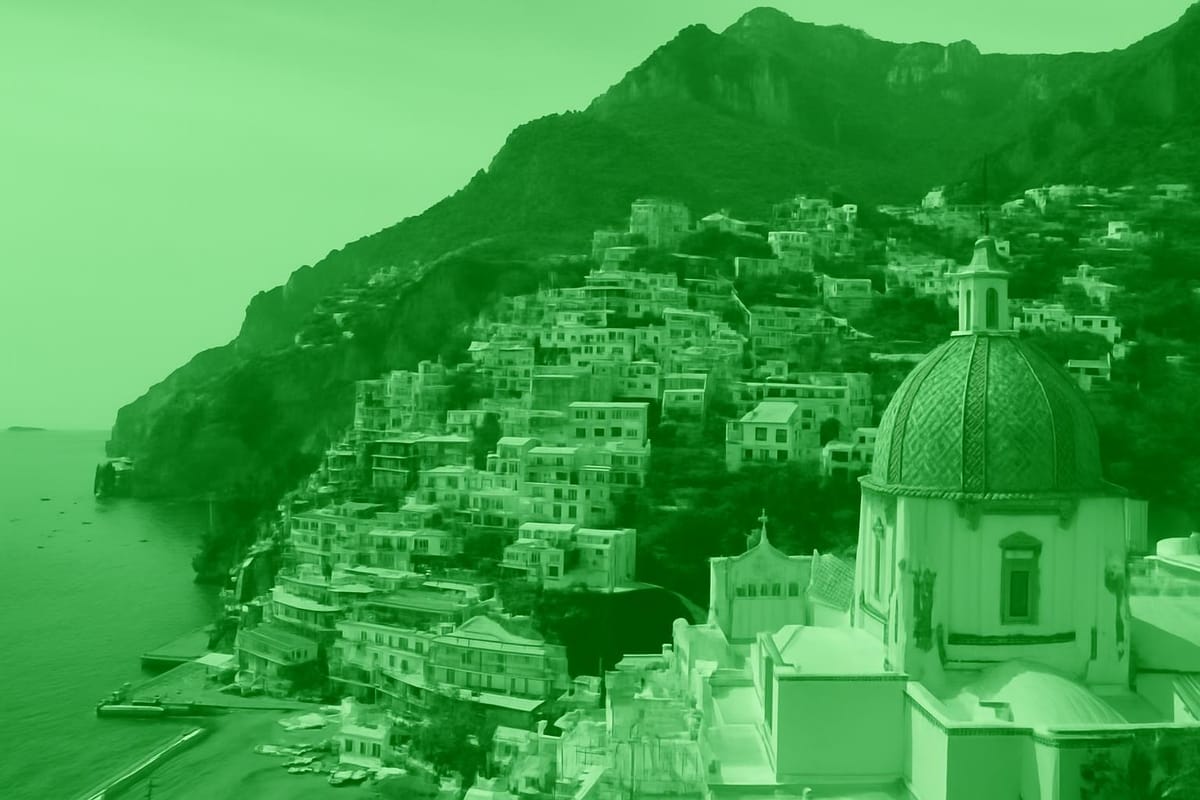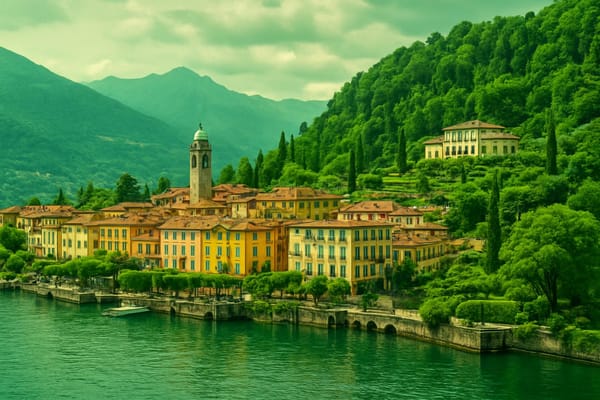Positano
Mediterranean cliffside escape: pastel houses, pebble beaches, boat tours, sunset views.

Important things to know about Positano
Positano is a sun-drenched coastal town in Italy where narrow, winding lanes spill down steep cliffs toward the Mediterranean, creating a layered tapestry of pastel façades, terraces and stairways that shape everyday life; its identity is defined as much by the rhythm of the sea and the hush of lemon groves as by the intimate scale of its neighborhood piazzas, and residents move through a landscape where architecture, light and color combine to form an unmistakable atmosphere. The local culture is woven from generations of fishing and artisan traditions, from small workshops producing hand-stitched fabrics and ceramics to family kitchens where recipes carry the scent of fresh herbs, olive oil and limoncello, reflecting a cuisine rooted in place and season. Life in Positano balances relaxed Mediterranean pacing with an attentive craft sensibility: fishermen, shopkeepers and designers coexist amid a network of steep alleys where daily routines - market visits, coffee pauses, maritime comings and goings - give the town a quietly vibrant tempo. Natural elements are ever-present, as the sea and sky shape light that shifts from brilliant azure to soft twilight, bathing buildings and terraces in shifting hues that have inspired artists and designers for decades. Despite its small footprint, Positano projects a strong sense of identity: an interplay of rugged geology and cultivated charm, a community sustained by local traditions and creative energy, and an enduring appeal grounded in authentic Mediterranean living rather than curated spectacle.
Sightseeing hot-spots in Positano
Positano, Italy is a postcard-perfect jewel on the Amalfi Coast, famous for its cascade of pastel houses tumbling down steep cliffs to the sea. Sightseeing in Positano means wandering narrow, winding lanes that open onto panoramic terraces and dramatic viewpoints, where the deep blue of the Mediterranean meets the sky. The lively Spiaggia Grande is the beating heart of the town, a pebble beach lined with colorful umbrellas and waterfront cafés ideal for soaking up sun and people-watching, while smaller hidden coves reward those who explore the coastline by foot or by boat.
At the center of Positano’s cultural charm is the Church of Santa Maria Assunta, instantly recognizable by its majolica-tiled dome and treasured Byzantine icon of the Madonna. Beyond the church, the compact town offers endless opportunities for shopping in boutique stores selling handmade sandals, ceramics, and linen - a highlight for many visitors. Culinary sightseeing is just as important: seaside trattorias serve fresh seafood and local specialties paired with limoncello and panoramic views, turning every meal into an experience as memorable as any landmark.
For those seeking active sightseeing, day trips and boat tours from Positano provide access to Capri’s grottos and the dramatic coastal cliffs, while the famous Path of the Gods offers one of the best hikes in Italy with sweeping vistas over the coastline. Photographers and romantics alike will find countless spots to capture sunrise and sunset light bathing the town in gold. Whether you come for relaxation, shopping, gastronomy, or adventure, Positano’s blend of natural beauty and timeless charm makes it an essential stop on any Amalfi Coast itinerary.
Hotels to enjoy in Positano
Positano is a jewel of the Amalfi Coast, and the selection of hotels in Positano reflects its dramatic cliffs, winding stairways and postcard-perfect beaches. From intimate boutique properties tucked into pastel facades to sprawling luxury resorts with private sea view terraces, Positano hotels offer unforgettable panoramas and authentic Italian charm. Travelers searching for romantic escapes often favor cliffside suites with panoramic windows and candlelit dinners on clifftop terraces, while families may choose more spacious accommodations with easy access to the pebble beachfront. The town’s compact layout means many hotels are within walking distance of quaint cafés, artisan shops and the waters where ferries depart for Amalfi and Capri, making these properties ideal bases for exploring the coastline.
Choosing the right Positano hotel can transform a trip into a lasting memory: amenities like infinity pools, rooftop bars at sunset, and on-site trattorias serving fresh local cuisine elevate the stay, while concierge services can arrange private boat tours, cooking classes and transfers. For best value and availability, consider booking early for peak months (June–September) or look for last-minute offers in shoulder seasons when the village is quieter and the light softer. Reviews frequently praise the combination of personalized service and stunning vistas that define the top-rated Positano hotels, so pay attention to recent guest experiences and room descriptions to ensure features like balcony sunset views or direct beach access. Whether you seek a cozy hideaway or an opulent retreat, Positano’s hotels promise a memorable Italian escape filled with breathtaking views, rich flavors and timeless Mediterranean elegance.
Restaurants to try in Positano
The restaurants of Positano are a sensory celebration where cliffside terraces and winding stairways lead to tables with breathtaking sea views. Along the Amalfi Coast, chefs blend fresh seafood, ripe tomatoes and fragrant herbs with centuries-old techniques, turning simple ingredients into unforgettable plates of handmade pasta and grilled fish. Whether you seek a casual beachfront trattoria or an elegant dining room perched above the harbor, Positano’s culinary scene emphasizes local cuisine, seasonal produce and the bright notes of local lemons that inspire everything from dressings to the signature limoncello. Even a quick meal here often becomes an event: sunlight on the water, the scent of garlic and basil in the air, and attentive service that makes every dinner feel both authentic and exceptional.
Dining in Positano is as much about the atmosphere as the food; many restaurants boast terraces that are perfect for a romantic dinner at sunset, while others invite lively conversations over family-style platters. From intimate spots that specialize in seafood caught that morning to refined kitchens offering modern takes on Mediterranean classics, the diversity of Positano restaurants appeals to gourmets and casual travelers alike. Reservations are wise during high season, and exploring alleyways and harbor-side promenades often reveals hidden gems where craftsmanship and hospitality are truly Italian. For those seeking the essence of the Amalfi Coast, a meal in Positano promises vibrant flavors, panoramic vistas and a timeless culinary memory.
Best shopping stops in Positano
Positano is a jewel on the Amalfi Coast where shopping feels like a discovery around every sunlit corner. Narrow lanes cascade down to the sea lined with brightly painted boutiques, ateliers and tiny galleries offering the very best of Italian craftsmanship. Visitors searching for fashion-forward pieces will find racks of flowing linen clothing and hand-stitched dresses from local designers that capture the effortless coastal elegance of Positano. Footwear is a highlight: bespoke handmade sandals crafted by skilled cobblers are available in a range of colors and styles, often customized on the spot for a perfect fit. Homeware and decorative ceramics reflect Mediterranean tastes, from hand-painted plates to unique vases, echoing the artisanal spirit of the region and promising memorable keepsakes from the Amalfi Coast.
Beyond clothing and ceramics, the town’s shops showcase a curated selection of gourmet products and souvenirs that reflect local flavors and traditions. Shelves are stocked with bottles of limoncello, jars of candied lemon peels and olive oil infused with aromatic herbs, perfect for gifting or preserving the taste of summer in Positano. Boutique owners and local artisans are happy to share stories about their techniques, creating an immersive shopping experience that blends culture and commerce. Whether you’re hunting for a tailored piece, a one-of-a-kind accessory, or classic coastal décor, shopping in Positano offers a charming mix of luxury, authenticity and handmade quality that captures the essence of la dolce vita.
Nightlife highlights in Positano
Positano nightlife unfolds like a cinematic scene on the Amalfi Coast, where winding streets lead to neon-lit terraces and the scent of lemon blossoms floats on the night air. As the sun dips behind the cliffs, locals and travelers gather for sunset cocktails at elegant bars perched above the sea, enjoying panoramic sea views and a warm Mediterranean breeze. Trendy beach clubs along the shoreline pulse with relaxed rhythms, while intimate wine bars invite quieter conversation and tastings of local limoncello and seafood-focused small plates. The atmosphere blends classic Italian charm with a cosmopolitan energy, making Positano nightlife ideal for both romantic getaways and lively evenings with friends.
After dinner, the town’s nightlife scene shifts from mellow aperitifs to late-night dancing and live sets at hidden clubs and terraces, where DJs mix contemporary beats with Italian classics. Street performances and live music in piazzas add spontaneous flair, and moonlit boat rides offer a private perspective of the illuminated coastline for couples seeking memorable romantic evenings. Whether you prefer sipping cocktails under the stars, sampling authentic regional cuisine, or joining a vibrant dance floor, Positano delivers a diverse and unforgettable night experience that captures the essence of the Amalfi coast.
Getting around in Positano
Positano does not have a railway station, so travelers searching for how to get to Positano will typically use a nearby airport and train hub combined with buses, ferries or private transfers; the nearest major international gateway is Naples International Airport (NAP), from which the fastest door-to-door option is a private transfer (about 60–90 minutes depending on traffic), while budget-minded visitors often take the Alibus or a taxi into Napoli Centrale and then the Circumvesuviana or regional trains toward Sorrento before switching to a scenic but winding SITA bus to Positano; alternatively, trains to Salerno connect the national rail network and offer a pleasant ferry to Positano in high season or a bus/car transfer, with combined travel times typically ranging from 1.5 to 3 hours depending on connections and season. Seasonal schedules matter: ferries operate mainly from spring through early fall and reduce service in winter, while roads can be slow in peak summer, so SEO-focused searches like Positano airport, train to Positano, Naples airport to Positano, and Salerno to Positano will surface options including airport shuttles, regional trains, SITA buses, ferries and private transfers to help you plan the most efficient route.
Culture must-see's in Positano
Positano sits like a cascade of color on the cliffs of the Amalfi Coast, and its culture is as layered and sun-drenched as the town’s famous stairways. Wandering narrow lanes reveals boutiques that define a local fashion aesthetic-flowing linen, hand-stitched sandals and vibrant prints that have become synonymous with Positano style. The Church of Santa Maria Assunta anchors community life, its Byzantine icon and majolica-tiled dome offering both spiritual resonance and photographic appeal. Artisans’ studios display hand-painted ceramics and woven goods, while small galleries and street murals celebrate the island’s artistic temperament. The rhythm of daily life-fishermen hauling in the catch, café tables filling at dawn, and evening passeggiata-keeps tradition alive, making Positano a living showcase of Italian coastal culture.
Culinary traditions are a cornerstone of Positano culture, where fresh seafood, homemade pasta and citrus-forward desserts pair perfectly with local limoncello and small-batch olive oil. Festivals and religious processions punctuate the year, bringing music, fireworks and communal feasts to the Spiaggia Grande and cliffside piazzas. Beyond the beaches, cultural experiences include boat trips to hidden grottos, cooking classes focused on Mediterranean flavors and artisan workshops where visitors can learn pottery or sandal-making. Photography enthusiasts and travelers seeking authentic Positano travel moments will find endless inspiration in sunrise vistas, terraced lemon groves and the warm hospitality of locals, all of which make Positano not just a destination but a vibrant cultural story on the Amalfi Coast.
History of Positano
Positano’s history is a layered story of sea, stone and survival on the Amalfi Coast of Italy. Archaeological finds and the steep terraces that climb the cliffs point to ancient settlement, with traces of Roman villas and agricultural plots that once grew olives and lemons for local use and export. During the Middle Ages Positano was tied to the fortunes of the Republic of Amalfi, a maritime power whose trade routes and shipbuilding shaped the economy of the coastline. The town’s narrow, winding alleys and defensive outposts grew in response to the age of piracy and political turmoil, while the Church of Santa Maria Assunta emerged as a spiritual and cultural focal point, sheltering a famed Byzantine icon of the Virgin believed to protect seafarers. Over centuries the rhythm of life remained tied to fishing and small-scale agriculture, the natural harbor offering a modest livelihood for generations of fishermen whose skill and seamanship defined Positano’s character long before mass tourism arrived.
In the 20th century Positano transformed from a sleepy fishing village into an international symbol of Mediterranean charm and tourism on the Amalfi Coast. Artists, writers and photographers discovered the picture-postcard harmony of pastel houses tumbling toward the sea, and cultural figures such as John Steinbeck helped popularize the town with evocative writing that captured its romantic appeal. The postwar decades saw skilled local artisans and couturiers turn simple linen and hand-dyed fabrics into a seasonal fashion language - “Positano style” - that attracted visitors seeking sun, sea and style. Today the town balances heritage and hospitality: narrow lanes still hide family-run workshops producing ceramics and textiles, the Church of Santa Maria Assunta continues to draw pilgrims and curious travelers to its Byzantine icon, and terraces carved into the cliffside recall the centuries of ingenuity required to live on this dramatic stretch of coast. Positano’s history remains an essential element of its charm, a story of ancient roots, maritime resilience and cultural reinvention that keeps visitors returning to experience the timeless beauty of this Mediterranean gem.



